How to Get Rid of Urine Smell from Carpet (For Good)
There’s a special kind of frustration that comes from walking into a room and being hit with that faint — but unmistakable — urine smell. It clings. It lingers. And no matter how much air freshener you spray or how many times you vacuum, it just won’t leave.
Whether it’s from a beloved pet, a toddler’s accident, or an aging family member, urine in carpet is one of those “invisible messes” that feels personal. You’ve cleaned it, scrubbed it, maybe even shampooed the area — but days later, that musky, sour odor creeps back up, especially when the weather’s humid or the sun hits the spot just right.
If this sounds familiar, you’re not alone. And most importantly, you’re not powerless.
The good news is: you can remove urine odor from carpet permanently, but it takes more than surface-level cleaning. The trick isn’t just masking the smell — it’s breaking down the uric acid crystals that embed deep in the carpet fibers and padding. If those aren’t treated properly, they reactivate every time the area gets damp, restarting the stink cycle all over again.
In this guide, we’ll walk through:
- Why urine smell is so hard to get rid of
- The biggest mistakes most people make
- The proven, step-by-step method that actually works
- Which cleaners work best (and which to avoid)
- What to do when nothing else works (including pro tips)
Whether you’re dealing with pet stains, potty training setbacks, or elderly care, this guide will help you get back to that fresh, clean-carpet feeling — without covering it up or tearing it out.
Section 1: Why Urine Smell Keeps Coming Back (Even After You Clean It)
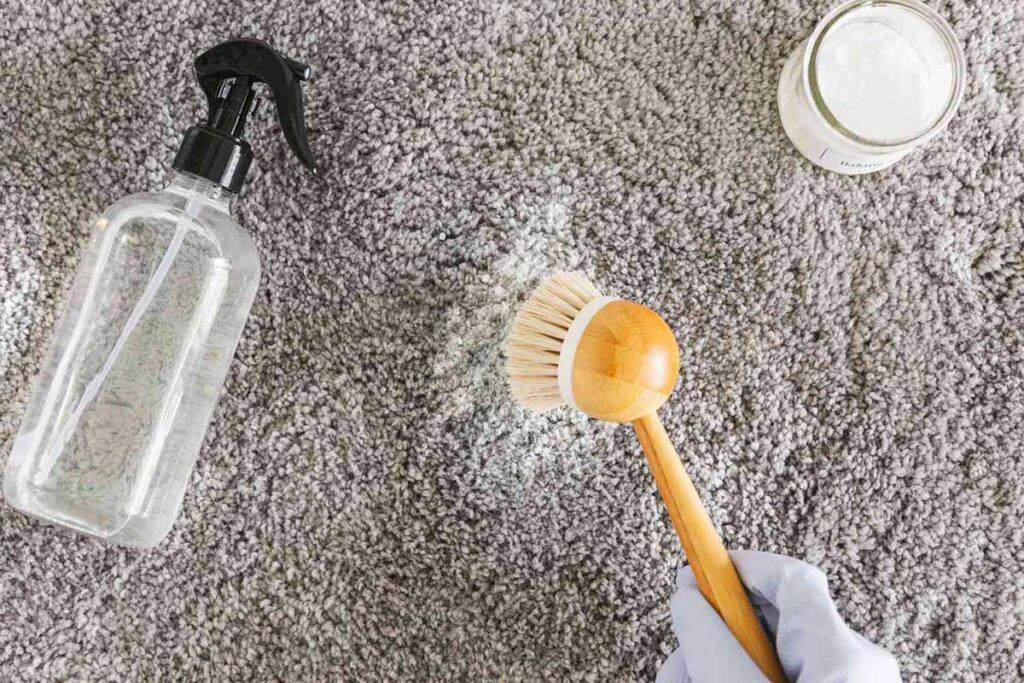
You scrub. You blot. You sprinkle baking soda and maybe even steam-clean. It smells better for a day or two… then it returns. Faint at first — then suddenly strong, like it never left. Why?
Because the real issue isn’t the stain you see — it’s what’s underneath the carpet.
When urine hits a carpet, it doesn’t just sit on the surface. It quickly seeps down through:
- The carpet fibers
- The backing
- The padding
- And sometimes even the subfloor
At every layer, uric acid crystals are left behind — and here’s the catch: these crystals are reactivated by moisture. That means every time the humidity rises, or someone walks on the area with damp feet, or you clean with water-based solutions… the smell reignites.
Why Regular Cleaners Don’t Work
Standard carpet cleaners and home remedies like vinegar or shampoo may remove the visible stain, but they don’t neutralize uric acid. At best, they cover up the odor temporarily. At worst, they spread the urine deeper into the padding.
Most household disinfectants are designed to kill bacteria — not break down urine compounds. And urine, unfortunately, is a chemical beast of its own.
Common Mistake:
- Using too much water → pushes urine deeper
- Saturating with vinegar or enzyme spray once → not enough time to break it down
- Covering with air fresheners or baking soda → traps the smell inside the padding
Real user insight:
“I thought I had cleaned it with vinegar and baking soda. It wasn’t until a heatwave hit that the entire living room started stinking again. I realized I never actually neutralized the stuff underneath the carpet.” – Pet owner, Reddit
Section 2: The Only Way to Truly Remove Urine Odor (Step-by-Step Guide)
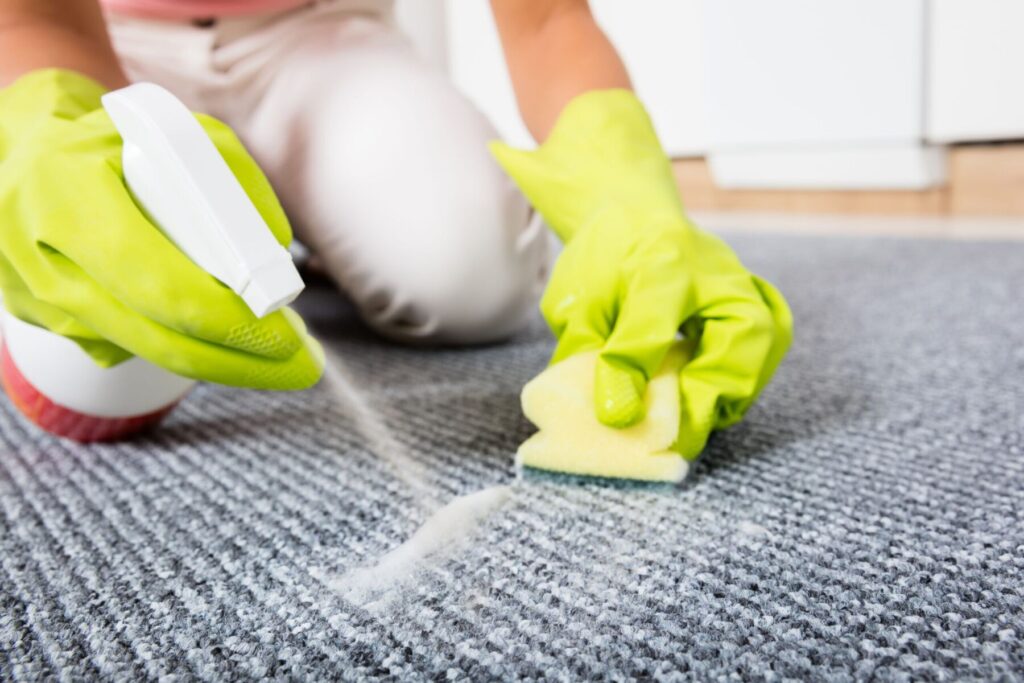
If you’re serious about getting rid of that awful urine smell — not just hiding it for a few days — you need to go deeper than surface cleaning. The good news? You don’t need to replace your carpet or hire a pro right away. But you do need to use the right method, with patience and purpose.
Here’s the exact, field-tested routine used by pet owners, landlords, and even Airbnb hosts — and yes, it actually works.
What You’ll Need:
- Clean white cloths or paper towels
- A good enzyme-based cleaner (like Rocco & Roxie, Nature’s Miracle, or Simple Solution)
- Blacklight flashlight (optional, but helps locate old spots)
- A spray bottle of clean water
- Plastic wrap or foil (yes, really)
- A stack of books or something heavy
- Optional: Shop vac or carpet extractor
Step 1: Identify the Entire Affected Area
You might think it’s just “that spot by the couch,” but if it’s an older or recurring accident, there’s probably more.
- Use your nose first — even if it feels weird, get close to the carpet and smell it
- At night, use a blacklight flashlight — urine glows yellow-green under UV light
- Lightly mark the area with chalk or tape if needed
Step 2: Blot — Don’t Rub
If the spot is still fresh:
- Use clean, dry cloths or paper towels to blot as much urine out as possible
- Apply downward pressure, or even stand on the towel — you want to pull the urine up, not spread it around
- Never scrub — this pushes it deeper into the carpet backing
If it’s a dry stain, move straight to Step 3.
Step 3: Apply Enzyme Cleaner (Generously)
Enzyme cleaners are the only type of product that can break down uric acid crystals. You’re not cleaning here — you’re neutralizing at a chemical level.
- Soak the affected area completely — more than you think
- Make sure the solution reaches deep into the padding (you can press it in using your hands or a sponge)
- Let it sit for at least 15–30 minutes — some brands recommend even longer for old stains
Important: Don’t use vinegar or bleach before enzyme spray. It can make enzymes ineffective.
Step 4: Cover and Let It Sit Overnight
This is the step most people skip — and it’s what makes all the difference.
- Cover the wet spot with plastic wrap or foil
- Put a heavy book or object on top to keep pressure
- Leave it overnight, or for at least 8–12 hours
This slows evaporation and gives the enzymes time to fully digest the urine molecules underneath. Rushing this step = lingering smell.
Step 5: Blot Again or Use Shop Vac
After sitting overnight:
- Remove plastic and blot up excess cleaner with a fresh cloth
- If you have a carpet extractor or wet/dry vac, now’s the time to use it
- If not, lay a thick towel over the area and press it down to draw moisture up
Step 6: Let It Dry Fully (Air Out the Room)
This might take 1–2 days depending on how deep the stain was:
- Open windows or use fans
- Avoid walking on the spot
- Once dry, give it a quick vacuum to lift fibers
At this point, 80–100% of the smell should be gone. In most cases, one deep treatment is enough. But if it’s an old or repeated stain, you might want to repeat the enzyme treatment one more time a few days later — that’s totally normal.
Real user feedback:
“I had a cat marking one corner for months. I did the plastic wrap + book trick with enzyme cleaner, and after 2 rounds, the smell never came back — even when it rained.” – Apartment dweller, Quora
Section 3: What If the Smell Still Won’t Go Away? (Extreme Fixes That Work)
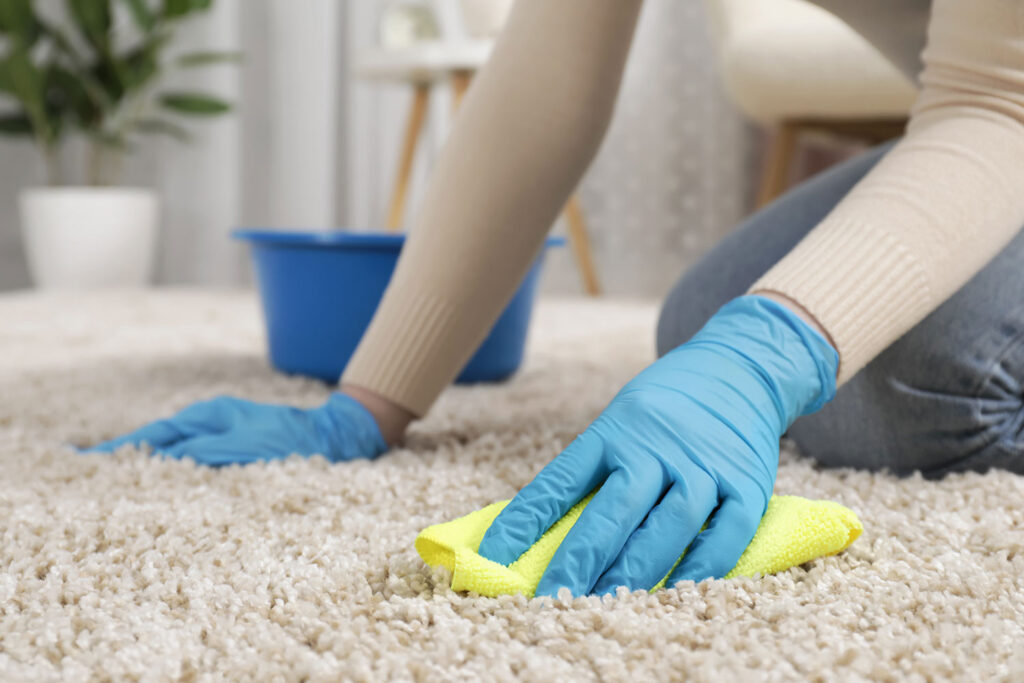
Sometimes, despite your best efforts, the smell lingers. It might fade for a day or two, only to creep back when it’s humid or the sun hits that area. When that happens, it usually means the urine soaked into the carpet padding or subfloor, and a standard surface treatment isn’t enough.
Don’t worry — you still have options before ripping up the carpet entirely.
Option 1: Deep Extraction With a Carpet Machine
Rent or buy a carpet cleaner with an extraction function (like a Rug Doctor or Bissell ProHeat). These machines work by:
- Spraying water or solution deep into the carpet
- Then extracting the liquid, pulling everything up from the base of the fibers
Pair this with an enzyme cleaner (spray it first, let it sit, then extract). Avoid over-wetting the carpet — it should feel damp, not soaked.
Tip: Don’t use heat or steam until the urine is fully neutralized — heat can set the odor.
Option 2: Replace the Padding (While Keeping the Carpet)
If the smell still returns and it’s concentrated in one spot:
- Pull back the carpet carefully
- Cut out the urine-soaked section of padding
- Scrub and treat the subfloor with hydrogen peroxide + baking soda
- Let it dry, replace with new padding, and lay carpet back down
It sounds like a big job, but many DIYers have done this with just a utility knife, gloves, and a staple gun. You’re salvaging the carpet while solving the problem at its root.
Option 3: Use a Sealing Odor Barrier on the Subfloor
If urine has soaked into wood or concrete subflooring, that smell can keep pushing up — no matter how much you clean the carpet above it.
In that case:
- Clean and fully dry the subfloor
- Apply a specialized odor-sealing primer, like Kilz Restoration or Zinsser BIN
- Let it cure, then reinstall carpet and padding
These products are used by landlords, renovators, and pet shelters to lock in urine odors when cleaning alone isn’t enough.
Last Resort: Professional Odor Removal Services
If all else fails, consider calling a local carpet restoration service or pet odor specialist. They use:
- UV lights to find hidden stains
- Industrial-strength extraction tools
- Deodorizers and ozone treatments (for full-home odor control)
Warning: Not all carpet cleaning services specialize in urine. Make sure they offer enzyme-based, odor-focused treatment — not just surface steam cleaning.
Real homeowner insight:
“We had cat urine on carpet and wood. DIY enzyme sprays helped short-term, but the smell came back every summer. We sealed the subfloor and replaced just the padding. Problem solved — finally.” – User from HomeImprovement subreddit
Section 4: What Cleaners Actually Work — Based on Real Reviews and Use-Cases
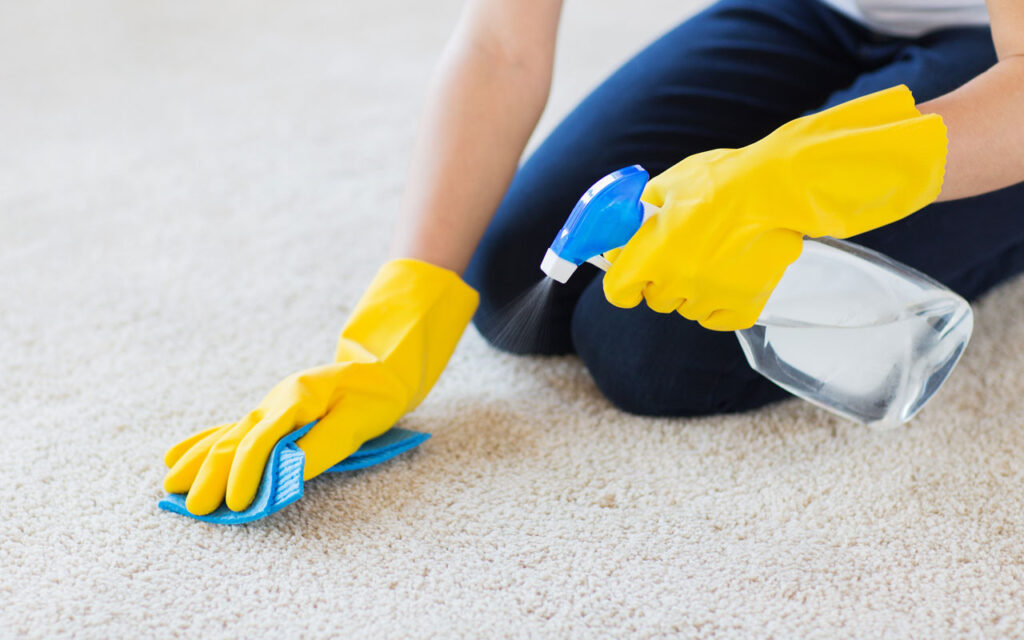
Walk down any cleaning aisle or scroll Amazon and you’ll find a dozen “pet urine odor removers.” But here’s the problem: most are glorified scented sprays or surface disinfectants. If you’re dealing with deep-set smells, you need a product that does two things well:
- Breaks down uric acid at a molecular level
- Reaches deep into carpet fibers and padding
Below are the most consistently recommended cleaners by real users — pet parents, landlords, and cleaners who’ve faced the worst of the worst.
1. Rocco & Roxie Professional Strength Stain & Odor Eliminator
Best For: Deep urine smells, old stains, pet repeat offenders
Why It’s Loved:
- One of the strongest bio-enzymatic formulas available
- No overpowering fake scent — just removes odor completely
- Works even on old, dried stains with deep soaking
“This saved me from replacing my carpet. I used it twice with a heavy book on top. Not a trace of smell left.” — Amazon review with over 60K ratings
2. Nature’s Miracle Advanced Stain and Odor Remover
Best For: Fresh accidents, multi-pet households
Why People Use It:
- Very accessible in stores
- Soaks deep and neutralizes quickly
- Safe for use around pets and kids
Pro tip: Buy the “Advanced” or “Severe Mess” formula — the basic one is gentler and better for light cleaning.
3. Simple Solution Extreme Pet Stain & Odor Remover
Best For: Carpets, upholstery, mattresses
What Makes It Unique:
- Contains 3x the enzymes of regular formulas
- Works great with spot treatment and shop vac extraction
- Includes a patented 3-in-1 spray head (stream, foam, mist)
“I had dog urine that kept ghosting back up through the pad. One heavy dose of this and the smell finally disappeared.” – Review from Chewy.com
4. Bubba’s Super Strength Commercial Enzyme Cleaner
Best For: Large areas, landlord-level cleaning jobs
What Users Say:
- Super concentrated — a little goes a long way
- Works well on subfloor pre-treatments before sealing
- Less fragrance than other brands (no perfume masking)
“This is the cleaner I use in rentals when someone had pets. It’s strong enough for repeat territory marks and still safe on carpet.” – Property manager forum comment
Honorable Mentions:
- Angry Orange Odor Eliminator – Not enzymatic, but great for surface deodorizing after a deeper clean
- Skout’s Honor Urine Destroyer – A gentler, eco-friendly option with plant-based enzymes
- ZorbX Unscented Cleaner – Works well if you’re scent-sensitive or allergic
Final Advice:
Enzyme cleaners must sit for hours to work. If you spray and wipe like a surface cleaner, it won’t fix the smell. Let it soak, cover, and wait.
Section 5: Prevention — How to Stop the Urine Problem from Returning
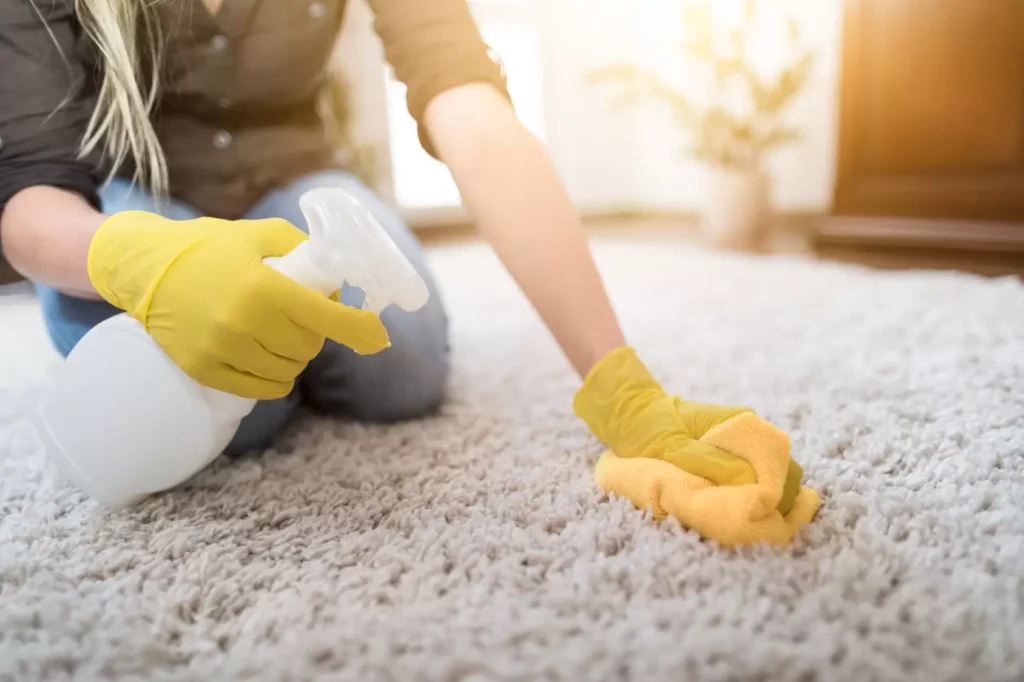
You’ve cleaned. You’ve soaked. You’ve finally silenced that lingering odor. Now comes the crucial part: keeping it from coming back.
Whether your problem is a potty-training pup, an elderly pet with accidents, or recurring toddler surprises — here’s how to protect your carpet long-term without driving yourself crazy.
1. Use an Enzyme Spray Weekly (Even if It’s Clean)
Think of this like brushing your teeth — it’s easier to prevent odor than to fix it.
- Spray a light mist of your enzyme cleaner in “accident-prone” zones
- Let it air dry — no need to blot or cover
- This keeps uric acid and odor molecules from ever setting in
Real-world logic: Even invisible or “missed” spots can build up over time. A regular maintenance spray resets the odor clock.
2. Try a Pet-Proof Carpet Protector
There are clear plastic or waterproof throw rugs that protect your carpet while staying nearly invisible.
- Great for spots like under food bowls, favorite napping zones, or door entrances
- Most are machine-washable or wipe-clean
- Some brands (like Gorilla Grip or Ruggable) have waterproof layers built-in
3. Limit Access During Risk Hours
If your pet or child tends to have accidents at night or while you’re away, block off that part of the home:
- Use a baby gate or close interior doors
- Place a pee pad or small washable rug as a buffer
- Leave a treat/toy/litter box nearby to avoid “marking” from anxiety
4. Address the Reason Behind the Accident
Sometimes repeated urine issues aren’t just behavioral — they’re medical or emotional.
- Senior pets may have bladder control problems (check with a vet)
- Cats might be avoiding a dirty or stressful litter box
- Dogs can mark from insecurity, boredom, or separation anxiety
- Kids might need a new bedtime routine or more positive reinforcement
Cleaning helps — but understanding the cause is the real fix.
5. Invest in a Small Carpet Spot Cleaner
If you’re dealing with frequent accidents, consider a portable carpet extractor like the Bissell Little Green or Hoover CleanSlate.
- Quick to pull out after an accident
- Gets deep into padding without over-wetting
- Works with enzyme cleaners
- Pays for itself in fewer headaches (and cleaner air)
“I used to dread cleaning pet stains. Now I just grab my Little Green and it’s gone in 10 minutes. No smell, no drama.” – Reddit user
Prevention Checklist (Quick Recap)
- Use enzyme spray weekly on problem areas
- Block off carpeted rooms when not home
- Address medical/behavioral triggers
- Protect floors with washable rugs or covers
- Use portable extractor for fast cleanup
- Keep mop/cleaning gear nearby — not buried in the garage
FAQs + Final Thoughts: Because It’s More Than Just a Smell
You’ve come this far because you’re tired of quick fixes and endless trial-and-error. So let’s address the real questions people search when dealing with carpet urine — the kind of questions that don’t have one-line answers.
Q1: Why does urine smell come back after I clean it?
Because urine soaks below the surface — into padding and subfloor. When it gets damp again (from humidity, cleaning, etc.), uric acid crystals reactivate, releasing odor unless fully neutralized with an enzyme cleaner.
Q2: Can I use vinegar and baking soda to fix it?
Only partially. Vinegar neutralizes odor on the surface, and baking soda can absorb some smell — but neither break down uric acid. It’s okay as a first aid measure, but not a long-term fix.
Q3: What’s the best cleaner to remove the smell for good?
Any high-quality enzymatic cleaner like Rocco & Roxie, Nature’s Miracle Advanced, or Bubba’s. These biologically digest urine compounds — they don’t just mask them.
Q4: Should I use bleach or steam cleaners on urine stains?
No. Bleach can damage carpet fibers and set the stain permanently. Steam can actually cook urine into the padding, locking in odor. Always use enzyme products before any heat treatment.
Q5: How can I tell if the smell is gone for good?
Wait until the carpet is fully dry, and check over a few days. Humidity and heat will usually reactivate any leftover odor. If the smell doesn’t return after a few weather changes, you’re in the clear.
Final Thoughts: You’re Not the Only One
Dealing with urine in carpet feels personal — like your home is working against you. But here’s the truth: even the cleanest homes face this issue. Pets get sick. Toddlers have accidents. Life happens.
The important part is that you’re not stuck with it.
With a little science (enzymes), some patience (overnight soak time), and a few tools (spray bottles, plastic wrap, a bit of pressure), you can actually solve the problem — not just cover it up.
It may take more effort than a regular stain, but once it’s done, you’ll notice the difference every time you walk in the room. Cleaner air. A lighter mood. And no weird smell chasing you around.
This isn’t just a cleaning fix — it’s taking back your space.


